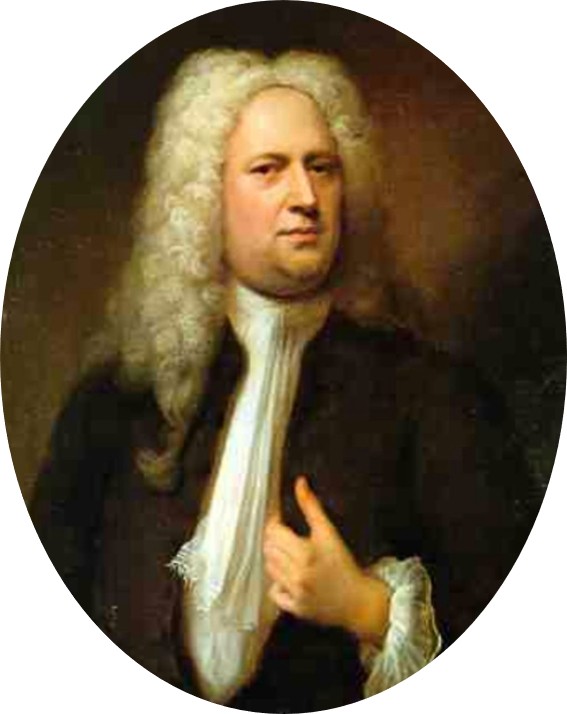The Eight Great Keyboard Suites by George Frideric Handel are not merely a significant contribution to the keyboard repertoire; they also showcase his versatility and mastery of the keyboard.
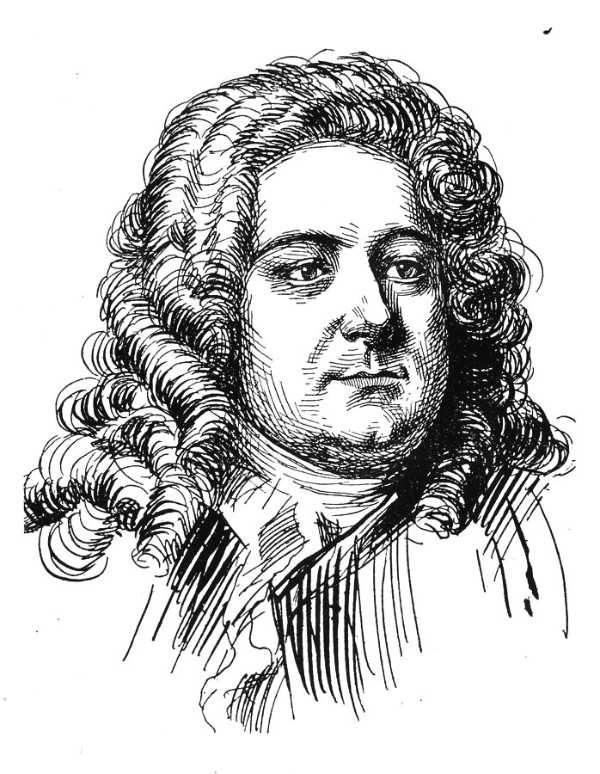
George Frideric Handel
Handel’s first biographer, John Mainwaring, who published his “Memoirs of the Life of the Late George Frederic Handel” in 1760, often praised Handel’s genius and virtuosity as a keyboardist.
Mainwaring viewed Handel’s keyboard skills as extraordinary, emphasising his ability to captivate audiences with improvisation and technical brilliance. He describes Handel’s early career performances in Italy, where his harpsichord and organ playing dazzled patrons.
George Frideric Handel: Keyboard Suite No. 5, “Prelude” (Seong-Jin Cho, piano)
The contemporary scholar and writer Charles Burney, meanwhile, suggests that Handel’s reputation as a harpsichord virtuoso informs the design of the Eight Great Keyboard Suites, with “their demanding passages reflecting the composer’s own improvisational flair.”
Burney specifically praised the Eight Great Suites for their stylistic synthesis, describing them as blending “the profundity and learned art of the Germans with Italian grace and lightness.”
He also noted their structural and expressive qualities, particularly highlighting the way Handel balanced rigorous counterpoint with melodic elegance, which he saw as a hallmark of Handel’s keyboard writing.
With such high praise in mind, let’s listen to Suites 5 to 8 of Handel’s eight great keyboard suites.
George Frideric Handel: Keyboard Suite No. 5, “Allemande” (Seong-Jin Cho, piano)
Suite No. 5 in E Major, HWV 430

Portrait of George Frideric Handel
Handel’s Suite No. 5 in E Major is probably the most accessible and exuberant of the set. The major tonality infuses every movement with warmth, and the famous “Harmonious Blacksmith” variations are all-time favourites with performers and listeners.
This crowd-pleaser is less intense than the Suite No. 4, yet it offers performers plenty of room for interpretative freedom, especially in the variations. The “Prelude” is bright and improvisatory and unfolds with cascading scales and arpeggios that sound like a spirited warm-up.
The rapid figurations and occasional chordal punctuations give it a bold, almost orchestral flair. What a perfect example for grabbing the attention of the listeners. The “Allemande” flows gracefully and balances lyricism with a gentle and forward-moving pulse.
George Frideric Handel: Keyboard Suite No. 5, “Courante” (Seong-Jin Cho, piano)
A smooth melody is delicately treated in a contrapuntal fashion, and Handel’s use of rhythmic variety and delicate ornaments adds plenty of charm. The lively and elegant “Courante” blends speedy runs with playful leaps, and the occasional harmonic surprise gives it a sparkling and carefree vibe.
The suite ends with Handel’s most famous single movement for harpsichord. It is a set of increasingly flamboyant variations on a sturdy and symmetrical English tune. The imaginative nickname “The Harmonious Blacksmith” does not come from Handel, but only appeared in the 19th century.
This catchy and lyrical tune is followed by five increasingly brilliant variations, with each one adding new textures. It builds in complexity while preserving the tune’s warmth, all culminating in a dazzling display of virtuosity. This is Handel’s crown jewel, cheerful and unforgettable.
George Frideric Handel: Keyboard Suite No. 5, “Air: Harmonious Blacksmith” (Seong-Jin Cho, piano)
Suite No. 6 in F-sharp minor, HWV 431
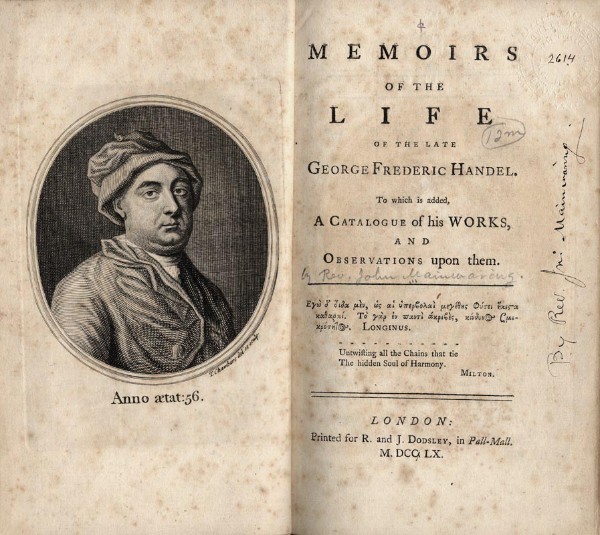
Memoirs of Handel
Handel’s 6th Suite is scored in the unusual and unconventional key of F-sharp minor, lending the set a distinctive and introspective edge. The opening “Prelude” is dark and restless, setting a moody tone with its rapid and swirling figurations.
We can still hear the dotted rhythms of a French Overture, but the chromatic inflexions and urgent arpeggios create a sense of unease and brooding inwardness. A performer writes, “In a blind test, the listener could be forgiven for mistaking this searching movement for Bach.”
George Frideric Handel: Keyboard Suite No. 6, “Prelude” (Dina Ugorskaja, piano)
While the opening Prelude is yet another example of Handel’s flair for dramatic openings, the sombre and lyrical “Largo” feels like a reflective interlude, with a vocal, almost operatic quality.
Building on dense textures and dotted rhythms, the simple and expressive melody unfolds over a steady bass. All is enriched by clashing dissonances, and the minor key provides a substantial emotional depth.
George Frideric Handel: Keyboard Suite No. 6, “Largo” (Dina Ugorskaja, piano)
The “Allegro” unfolds like a tautly argued fugue, presenting an angular main theme supported by a counter-subject that stretches across the bar line. Spirited and incisive, this fugue creates a sense of playful pursuit and lightens the overall mood of this suite.
Handel is rather famous for his self-borrowing and his musical recycling activity. As such, it’s not really surprising to hear this fugue, somewhat reworked, in his D-minor Concerto Grosso, Op. 3 No. 5.
George Frideric Handel: Keyboard Suite No. 6, “Allegro” (Dina Ugorskaja, piano)
The concluding “Gigue” presents a brisk and dance-like finale. The syncopated rhythms and minor key provide a somewhat mischievous charm, and some pungent harmonic clashes are reminiscent of a rustic English jig.
George Frideric Handel: Keyboard Suite No. 6, “Gigue” (Dina Ugorskaja, piano)
Suite No. 7 in G minor, HWV 432
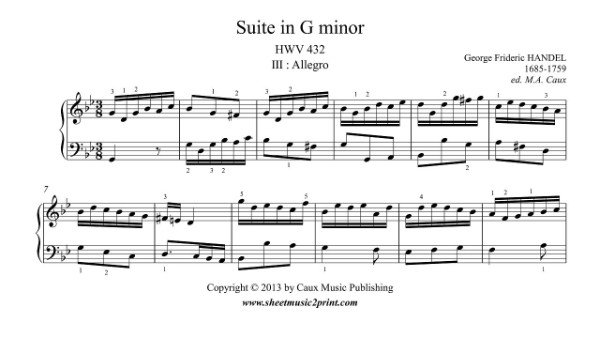
Handel’s Suite No. 7 “Allegro”
Handel’s Keyboard Suite No. 7 in G Minor is a richly expressive and dynamic work, blending introspective depth with virtuosic brilliance. It’s a tour de force balancing the intensity of the minor key with moments of lightness and grandeur.
It is frequently called one of Handel’s most ambitious suites, demanding both technical skill and emotional depth. One thing is for sure, it’s six movements showcase Handel’s mastery of contrast and emotional range.
George Frideric Handel: Keyboard Suite No. 7, “Overture” (Martin Souter, harpsichord)
It all starts with a grand and dramatic “Overture” in the French style. The slow dotted-rhythm in the introduction almost suggests a massive Baroque organ, while the jerky presto fugue sounds almost like Purcell. The contrast between the opening majestic chords and the jittery fugue sets a theatrical tone for the entire suite.
George Frideric Handel: Keyboard Suite No. 7, “Andante” (Martin Souter, harpsichord)
The “Andante” showcases flowing lyricism and a warm and reflective contrast to the drama in the overture. The singing melody is enriched by gentle counterpoint, and the minor tonality and subtle chromatic touches provide an almost melancholic charm.
George Frideric Handel: Keyboard Suite No. 7, “Allegro” (Martin Souter, harpsichord)
Sprightly and buoyant, the “Allegro” dances with playful and upbeat energy. With straightforward rhythmic vitality and occasional harmonic surprises, you can hear some brief major-key interjections, keeping this dance engaging and fresh.
Full of nobility and simplicity, the “Sarabande” exudes dignity and emotional weight. A deliberate pulse and a richly harmonised melody create an introspective mood, and the sombre chord progressions are perfect for nuanced dynamics on harpsichord or piano.
George Frideric Handel: Keyboard Suite No. 7, “Sarabande” (Martin Souter, harpsichord)
The bouncy three-part Gigue provides a burst of energy with its skipping and dance-like rhythm. There are plenty of fugal elements as the themes weave through an imitative texture. This dance has mischievous charm, and we would expect the suite to end here.
George Frideric Handel: Keyboard Suite No. 7, “Gigue” (Martin Souter, harpsichord)
Instead, Handel crowns this set with a magnificent Passacaille, or Chaconne in a marching rhythm. A simple four-bar theme provides the base for 16 variations that grow in complexity and brilliance. The repeated chord sequence is simple at first, but chromatically intensifies before reaching a dazzling climax.
George Frideric Handel: Keyboard Suite No. 7, “Passacaille” (Martin Souter, harpsichord)
Suite No. 8 in F minor, HWV 433
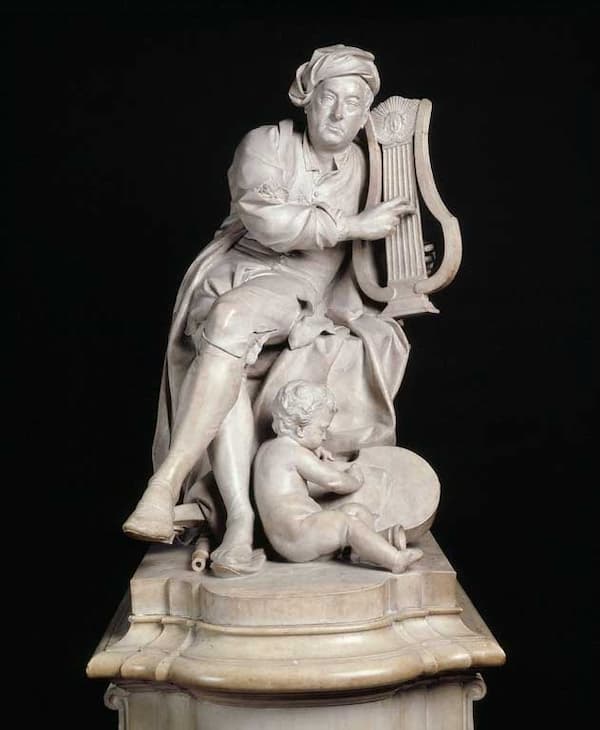
Marble statue of Handel, 1738
One of Handel’s most emotionally intense sets, the Keyboard Suite No. 8 is scored in the key of F minor. Handel frequently uses this specific key in his operas and oratorios for statements of special poignancy. That expressive and dark key also lends a brooding and tragic character to the five moments of this suite.
George Frideric Handel: Keyboard Suite No. 8, “Prelude” (Lisa Smirnova, harpsichord)
And it is the turbulent “Prelude” that sets the dramatic tone with its restless arpeggiated figures and chromatic flourishes. It all evokes a stormy and operatic atmosphere, and a scholar writes, “here Handel rivals Bach in chromatic inwardness.”
George Frideric Handel: Keyboard Suite No. 8, “Allegro” (Lisa Smirnova, harpsichord)
The “Allegro” is a driving fugue that channels the intensity of the prelude into a focused rhythmic drive. The angular subject unfolds via close imitative entries, and the counter-subject marches like a Baroque ground bass.
George Frideric Handel: Keyboard Suite No. 8, “Allemande” (Lisa Smirnova, harpsichord)
Graceful yet melancholic, the “Allemande” flows with a reflective and lyrical quality. Full of delicate contrapuntal interplay, this dance has an introspective feel and provides opportunity for expressive ornamentation.
George Frideric Handel: Keyboard Suite No. 8, “Courante” (Lisa Smirnova, harpsichord)
The “Courante” borrows its opening from Handel’s “Roman Vespers Psalm,” and the running scales and playful leaps create a sense of forward motion. Brief shifts to the major key provide a bit of charm to lighten the mood a little.
Lively canonic imitation is once again featured in the “Gigue.” It is a virtuosic finale, full of energy and contrapuntal wit. We hear plenty of chromatic flourishes, and the rapid figuration demands great dexterity. It certainly is a thrilling concluding flourish and rewards performers and listeners with its dramatic flair.
George Frideric Handel: Keyboard Suite No. 8, “Gigue” (Lisa Smirnova, harpsichord)
Conclusion
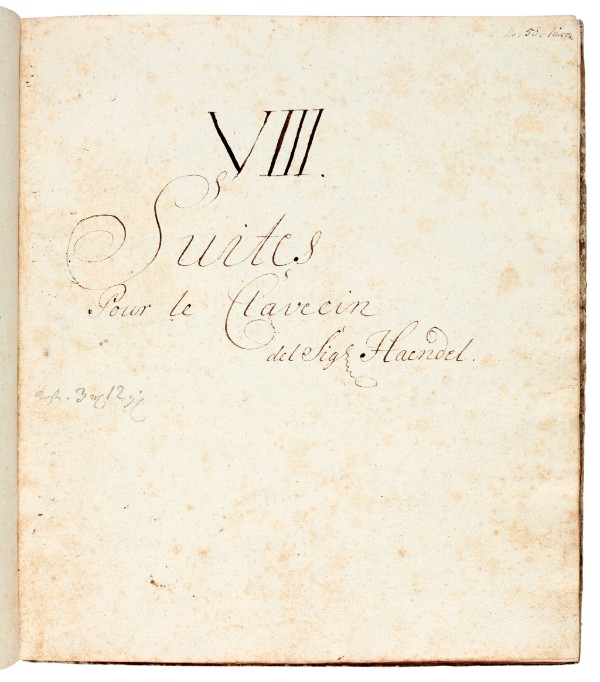
Handel’s Eight Keyboard Suites manuscript
Both Bach and Handel are towering figures, and in their keyboard suites, they share the same foundational structure. Both draw on traditional dances, often with introductory movements, but they diverge in style, intent, and expressive character.
Bach’s suites are meticulously crafted, emphasising intricate counterpoint, structural rigour, and intellectual depth. He creates a sense of architectural unity across his suites, and his dense harmonic language crafts profound musical essays.
In contrast, Handel’s keyboard suites are more theatrical, infused with operatic flair and prioritising expressive immediacy over contrapuntal complexity. Bach seems to have a private dialogue with the instrument, while Handel is much more extroverted in his musical expression.
Maybe we can say that Bach invites contemplation, and that Handel captivates with personality and direct emotional appeal. What do you think? I would love to hear your opinions on that topic.
For more of the best in classical music, sign up for our E-Newsletter

